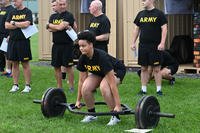Getting your first pull-up is a big achievement. Pushing into the double digits is even more impressive. People often get stuck in the 10-12 zone and fail to break into the teens and 20s. Here are some ways to help you progress into that higher range without breaking yourself.
Here is an email from a candidate facing just such a situation.
Hello Stew, I have never been able to get past 10 pull-ups with clean form. It seems the higher rep range is harder to access. Today I just tried doing negatives to experience high-rep ranges, ended up doing negative pull-ups controlled but all in the higher-rep ranges 13-22. I felt that my back muscles may lack endurance. I ended up doing 103 pull-up negatives. Will these help me or am I wasting my time? Thanks, Sammy.
Wow, that is a lot of negatives. My advice is not to do that many negatives. I bet you were sore. I have seen people get rhabdomyolysis by doing this many pull-up negatives over the years. If I had been there, I would have given them some guidelines for adding more negative reps to their workouts. In a nutshell, if you cannot do 10 pull-ups, I would not do more than 10 negative reps in a workout and not 100 reps total (regular and negatives).
For people who can do 10 reps of pull-ups and want to push into the higher teens and 20s, I typically recommend they follow some basic rules of training.
1. Do not do pull-ups every day
If you are doing 5-10 times your one-set max on a workout day, you do not want to do that many day after day after day. With this type of volume, you need a rest day. Consider pull-ups (and dips) the heavy-lifting exercises of the calisthenics world. You would not do back-to-back-to-back days of bench presses if you wanted to see gains while avoiding overuse pains or actually getting worse results than if you did a normal split routine.
2. Try the PT pyramid
Use this workout as an assessment tool, with the goal of achieving a 1-10-1 full pyramid of pull-ups, push-ups, abs of choice, and dips or air squats mixed in to provide an active rest between doing pull-ups again in the next round. Even though you can do 10 pull-ups when fresh, building up to set 10 of the pyramids is tough, but this workout will help you build the muscle stamina and endurance you need to add more repetitions.
3. After 10 reps, it becomes an endurance game
It takes strength to do your first one or two pull-ups, and these are often the hardest to achieve. However, to get into double digits and into the 20s in your max-rep effort sets, you need to turn a strength exercise into an endurance (muscle stamina) exercise. You do this by increasing the volume three times a week. Every other day helps with recovery, and it is the recovered muscles that grow stronger and more durable. You get stronger when you recover, not when you constantly crush your muscles.
4. Beware of making your total volume too high
If you do multiple small sets, you can build your volume of the reps up to 100 or even 150+. I would not try that volume if you cannot get 18-20+ reps in a single set. For now, if you're at 10 or less, strive for 50-75 max in a workout.
You may see progress with the pyramid workout from tip #2. As long as you are not failing any reps, you can first push these limits using the pyramid PT structure to help build a solid base to improve your pull-up max and overall volume.
5. What to do instead of high-rep negatives
Try downshifting from pull-ups after you reach fatigue and resort to other muscle-pulling exercises such as pulldowns, heavy rows or biceps curls. These exercises focus on the muscles that must work together to improve your pull-ups. You can make it a circuit like this:
- Pull-ups max effort
- Pulldowns 5-10
- Dumbbell rows 10 per arm
- Biceps curls 10
This will add some auxiliary pulling exercises to your pull-ups and help you isolate if back or biceps weakness is preventing you from doing more pull-ups.
6. Add variety to your workouts
Try the pyramid, super sets (you can add a weight vest of 10-15 pounds) and max-rep sets. These three workouts spread throughout the week every other day are a classic military PT test method that has worked for generations of PT test takers, military and spec ops members alike.
My recommendation is to build your overall volume over time just as you would with running miles. Start with regular pull-ups, but top off a few sets in the workout with a negative or two. I would not do more negatives of an exercise than what you can do in a single set. If you only can do 10 pull-ups with good form, then only do up to 10 negatives total in a workout spread out over multiple sets.
See ideas here: Classic Week of Military PT Training
Spec ops level: Classic Week of Military Special Ops Training (with swimming)
Pull-up article series: Getting 1st Pull-ups, Getting to 10 Pull-ups, Getting Over 20 Pull-ups
Stew Smith is a former Navy SEAL and fitness author certified as a Strength and Conditioning Specialist (CSCS) with the National Strength and Conditioning Association. Visit his Fitness eBook store if you're looking to start a workout program to create a healthy lifestyle. Send your fitness questions to stew@stewsmith.com.
Want to Learn More About Military Life?
Whether you're thinking of joining the military, looking for fitness and basic training tips, or keeping up with military life and benefits, Military.com has you covered. Subscribe to Military.com to have military news, updates and resources delivered directly to your inbox.


















